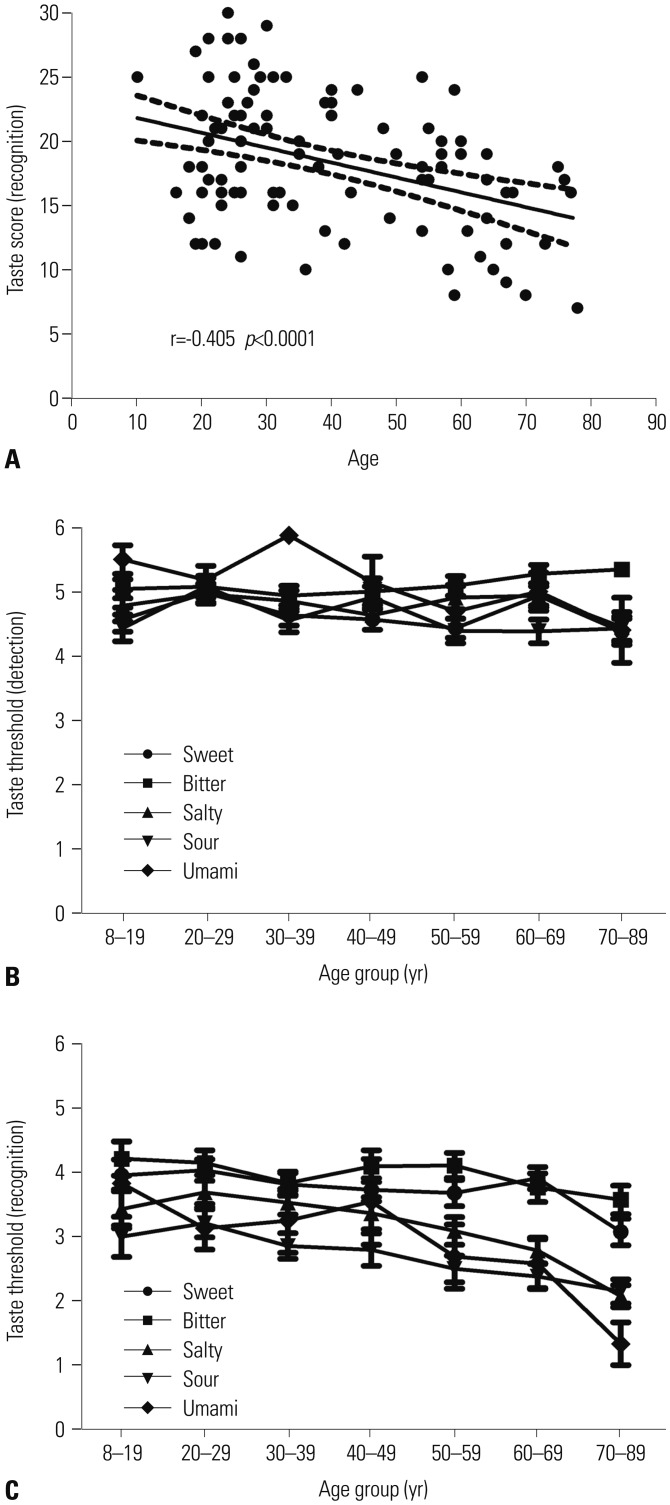1. Ikeda M, Aiba T, Ikui A, Inokuchi A, Kurono Y, Sakagami M, et al. Taste disorders: a survey of the examination methods and treatments used in Japan. Acta Otolaryngol. 2005; 125:1203–1210. PMID:
16353402.

2. Boesveldt S, Lindau ST, McClintock MK, Hummel T, Lundstrom JN. Gustatory and olfactory dysfunction in older adults: a national probability study. Rhinology. 2011; 49:324–330. PMID:
21858264.

3. Boesveldt S, Verbaan D, Knol DL, Visser M, van Rooden SM, van Hilten JJ, et al. A comparative study of odor identification and odor discrimination deficits in Parkinson's disease. Mov Disord. 2008; 23:1984–1990. PMID:
18759360.

4. Naudin M, Mondon K, El-Hage W, Perriot E, Boudjarane M, Desmidt T, et al. Taste identification used as a potential discriminative test among depression and Alzheimer's disease in elderly: a pilot study. Psychiatry Res. 2015; 228:228–232. PMID:
25998001.

5. Henkin RI, Schecter PJ, Friedewald WT, Demets DL, Raff M. A double blind study of the effects of zinc sulfate on taste and smell dysfunction. Am J Med Sci. 1976; 272:285–299. PMID:
797259.

6. Tomita H, Ikeda M, Okuda Y. Basis and practice of clinical taste examinations. Auris Nasus Larynx. 1986; 13(Suppl 1):S1–S15.

7. Landis BN, Welge-Luessen A, Brämerson A, Bende M, Mueller CA, Nordin S, et al. “Taste Strips” - a rapid, lateralized, gustatory bedside identification test based on impregnated filter papers. J Neurol. 2009; 256:242–248. PMID:
19221845.

8. Nelson G, Chandrashekar J, Hoon MA, Feng L, Zhao G, Ryba NJ, et al. An amino-acid taste receptor. Nature. 2002; 416:199–202. PMID:
11894099.

9. Chaudhari N, Landin AM, Roper SD. A metabotropic glutamate receptor variant functions as a taste receptor. Nat Neurosci. 2000; 3:113–119. PMID:
10649565.

10. Ikeda K. New seasonings. Chem Senses. 2002; 27:847–849. PMID:
12438213.

11. Schiffman SS, Graham BG. Taste and smell perception affect appetite and immunity in the elderly. Eur J Clin Nutr. 2000; 54(Suppl 3):S54–S63. PMID:
11041076.

12. Soter A, Kim J, Jackman A, Tourbier I, Kaul A, Doty RL. Accuracy of self-report in detecting taste dysfunction. Laryngoscope. 2008; 118:611–617. PMID:
18182967.

13. Cho JH, Jeong YS, Lee YJ, Hong SC, Yoon JH, Kim JK. The Korean version of the Sniffin' stick (KVSS) test and its validity in comparison with the cross-cultural smell identification test (CC-SIT). Auris Nasus Larynx. 2009; 36:280–286. PMID:
18775610.

14. Syed Q, Hendler KT, Koncilja K. The impact of aging and medical status on dysgeusia. Am J Med. 2016; 129:753.

15. Lee JW, Son HJ, Shin SH, Rhyu MR, Kim JY, Ye MK. Differences in taste thresholds according to sex and age groups in Korean. Korean J Otorhinolaryngol-Head Neck Surg. 2014; 57:692–697.

16. Stinton N, Atif MA, Barkat N, Doty RL. Influence of smell loss on taste function. Behav Neurosci. 2010; 124:256–264. PMID:
20364885.

17. Yamauchi Y, Endo S, Sakai F, Yoshimura I. A new whole-mouth gustatory test procedure. 1. Thresholds and principal components analysis in healthy men and women. Acta Otolaryngol Suppl. 2002; 122:39–48.
18. Doty RL, Shaman P, Dann M. Development of the University of Pennsylvania Smell Identification Test: a standardized microencapsulated test of olfactory function. Physiol Behav. 1984; 32:489–502. PMID:
6463130.

19. Kobal G, Klimek L, Wolfensberger M, Gudziol H, Temmel A, Owen CM, et al. Multicenter investigation of 1,036 subjects using a standardized method for the assessment of olfactory function combining tests of odor identification, odor discrimination, and olfactory thresholds. Eur Arch Otorhinolaryngol. 2000; 257:205–211. PMID:
10867835.

20. Nagraj SK, Naresh S, Srinivas K, Renjith George P, Shrestha A, Levenson D, et al. Interventions for the management of taste disturbances. Cochrane Database Syst Rev. 2014; 11. 26. [Epup]. DOI:
10.1002/14651858.CD010470.pub2.

21. Schiffman SS, Warwick ZS. Effect of flavor enhancement of foods for the elderly on nutritional status: food intake, biochemical indices, and anthropometric measures. Physiol Behav. 1993; 53:395–402. PMID:
8446704.

22. Satoh-Kuriwada S, Kawai M, Iikubo M, Sekine-Hayakawa Y, Shoji N, Uneyama H, et al. Development of an umami taste sensitivity test and its clinical use. PLoS One. 2014; 9:e95177. PMID:
24748056.

23. Gudziol H, Hummel T. Normative values for the assessment of gustatory function using liquid tastants. Acta Otolaryngol. 2007; 127:658–661. PMID:
17503237.

24. Mueller C, Kallert S, Renner B, Stiassny K, Temmel AF, Hummel T, et al. Quantitative assessment of gustatory function in a clinical context using impregnated “taste strips”. Rhinology. 2003; 41:2–6. PMID:
12677732.
25. Wolf A, Illini O, Uy D, Renner B, Mueller CA. A new extension to the Taste Strips test. Rhinology. 2016; 54:45–50. PMID:
26462295.

26. Pingel J, Ostwald J, Pau HW, Hummel T, Just T. Normative data for a solution-based taste test. Eur Arch Otorhinolaryngol. 2010; 267:1911–1917. PMID:
20495925.

27. Sasano T, Satoh-Kuriwada S, Shoji N, Sekine-Hayakawa Y, Kawai M, Uneyama H. Application of umami taste stimulation to remedy hypogeusia based on reflex salivation. Biol Pharm Bull. 2010; 33:1791–1795. PMID:
21048301.

28. Mueller CA, Pintscher K, Renner B. Clinical test of gustatory function including umami taste. Ann Otol Rhinol Laryngol. 2011; 120:358–362. PMID:
21774441.

29. Tsutsumi R, Goda M, Fujimoto C, Kanno K, Nobe M, Kitamura Y, et al. Effects of chemotherapy on gene expression of lingual taste receptors in patients with head and neck cancer. Laryngoscope. 2016; 126:E103–E109. PMID:
26422579.

30. Prutkin J, Fisher EM, Etter L, Fast K, Gardner E, Lucchina LA, et al. Genetic variation and inferences about perceived taste intensity in mice and men. Physiol Behav. 2000; 69:161–173. PMID:
10854927.

31. Hong JH, Chung JW, Kim YK, Chung SC, Lee SW, Kho HS. The relationship between PTC taster status and taste thresholds in young adults. Oral Surg Oral Med Oral Pathol Oral Radiol Endod. 2005; 99:711–715. PMID:
15897858.

32. Ribeiro JC, Chaves M, Chaves C, Lemos L, Silva ED, Paiva A, et al. Cross-cultural validation of a taste test with paper strips. Eur Arch Otorhinolaryngol. 2016; 273:3407–3411. PMID:
27071772.

33. Yang L, Wei Y, Yu D, Zhang J, Liu Y. Olfactory and gustatory function in healthy adult Chinese subjects. Otolaryngol Head Neck Surg. 2010; 143:554–560. PMID:
20869568.








 PDF
PDF ePub
ePub Citation
Citation Print
Print





 XML Download
XML Download